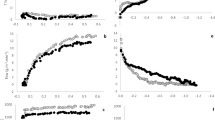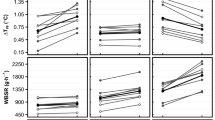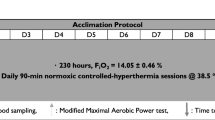Abstract
Many thermal physiologists follow the conventional wisdom that physiological heat adaptations occur in the summer for people living in a humid continental climate (e.g. Central Canada, North-eastern and Mid-western United States and Eastern Europe); therefore experimentation across seasons is often avoided. However, since modern behavioral adaptations, such as air conditioning, are accessible and commonplace, it is not clear whether such physiological adjustments actually do occur. It was hypothesized that despite warm weather, residing in a humid continental climate throughout a summer will not elicit any significant physiological heat adaptations since the environmental stimulus for such adjustments will be mitigated by behavioral adaptations. Eight young healthy male volunteers cycled at 60% VO2max for 90-min in a temperate environment before (mid-May) and at the end of (start of September) summer. Core temperature [measured in the esophagus (T es), rectum (T re) and aural canal (T au)], mean skin temperature (T sk), forearm skin blood flow (SkBf), upper back sweat rate (LSR) and heart rate (HR) were measured throughout exercise. Weekly activity logs and a lifestyle questionnaire were also administered throughout the summer months. No significant differences between pre- and end-summer were observed throughout exercise for T es (p = 0.565), T re (p = 0.350), T au (p = 0.261), T sk (p = 0.955), SkBf (p = 0.112), LSR (p = 0.394) or HR (p = 0.343). Likewise, the thermosensitivity and T es at the onset threshold for LSR (p = 0.177, p = 0.512) and SkBf (p = 0.805, p = 0.556) were also not significantly different. The apparent lack of heat acclimatization could be due to frequent air-conditioning use and an avoidance of outdoor activity during the hottest times of day but may also be due to a lack of environmental stimulus.





Similar content being viewed by others
References
Armstrong LE, Hubbard RW, DeLuca JP, Christensen EL (1987) Heat acclimatization during summer running in the northeastern United States. Med Sci Sports Exerc 19:131–136
Bates GP, Miller VS (2008) Sweat rate and sodium loss during work in the heat. J Occup Med Toxicol 3:4
Canada S (2000) Commercial and Institutional Building Energy Use Survey. Statistics Canada
Canada S (2009) Dwelling Characteristics and Household Equipment for Canadian Provinces/Territories and Selected Metropolitan Areas. Statistics Canada
Chinevere TD, Kenefick RW, Cheuvront SN, Lukaski HC, Sawka MN (2008) Effect of heat acclimation on sweat minerals. Med Sci Sports Exerc 40:886–891
CSEP (1986) Canadian Society for Exercise Physiology:Certified Fitness Appraiser Resource Manual, Ottawa, ON
Fox RH, Goldsmith R, Hampton IF, Hunt TJ (1967) Heat acclimatization by controlled hyperthermia in hot–dry and hot–wet climates. J Appl Physiol 22:39–46
Havenith G, Luttikholt VG, Vrijkotte TG (1995) The relative influence of body characteristics on humid heat stress response. Eur J Appl Physiol Occup Physiol 70:270–279
Henane R, Bittel J (1975) Changes of thermal balance induced by passive heating in resting man. J Appl Physiol 38:294–299
Ihzuka H, Hori S, Akamatsu T (1986) Seasonal variations of physiological responses to heat of subtropical and temperate natives. Int J Biometeorol 30:107–113
Inoue Y, Nakao M, Okudaira S, Ueda H, Araki T (1995) Seasonal variation in sweating responses of older and younger men. Eur J Appl Physiol Occup Physiol 70:6–12
Kondo N, Takano S, Aoki K, Shibasaki M, Tominaga H, Inoue Y (1998) Regional differences in the effect of exercise intensity on thermoregulatory sweating and cutaneous vasodilation. Acta Physiol Scand 164:71–78
Kruk J (2009) Physical activity and health. Asian Pac J Cancer Prev 10:721–728
Marcus P (1972) Heat acclimatization by exercise-induced elevation of body temperature. J Appl Physiol 33:283–288
Masterton J, Richardson F (1979) Humidex, a method of quantifying human discomfort due to excessive heat and humidity In: Environment Canada AES (ed), Downsview, Ontario, p. 45
McMurray RG, Horvath SM (1979) Thermoregulation in swimmers and runners. J Appl Physiol 46:1086–1092
Mekjavic IB, Rempel ME (1990) Determination of esophageal probe insertion length based on standing and sitting height. J Appl Physiol 69:376–379
Moseley PL (1994) Mechanisms of heat adaptation: thermotolerance and acclimatization. J Lab Clin Med 123:48–52
Nadel E (ed) (1977) Problems with temperature regulation during exercise. Academic Press, Inc, New York, NY
Nagashima K (2006) Central mechanisms for thermoregulation in a hot environment. Ind Health 44:359–367
Nielsen B (1998) Heat acclimation—mechanisms of adaptation to exercise in the heat. Int J Sports Med 19(Suppl 2):S154–S156
Nielsen B, Hales JR, Strange S, Christensen NJ, Warberg J, Saltin B (1993) Human circulatory and thermoregulatory adaptations with heat acclimation and exercise in a hot, dry environment. J Physiol 460:467–485
Pandolf KB, Cadarette BS, Sawka MN, Young AJ, Francesconi RP, Gonzalez RR (1988) Thermoregulatory responses of middle-aged and young men during dry–heat acclimation. J Appl Physiol 65:65–71
Ramanathan NL (1964) A new weighting system for mean surface temperature of the human body. J Appl Physiol 19:531–533
Roberts MF, Wenger CB, Stolwijk JA, Nadel ER (1977) Skin blood flow and sweating changes following exercise training and heat acclimation. J Appl Physiol 43:133–137
Romanovsky AA (2007) Thermoregulation: some concepts have changed. Functional architecture of the thermoregulatory system. Am J Physiol Regul Integr Comp Physiol 292:R37–R46
Sawka MN, Young AJ, Francesconi RP, Muza SR, Pandolf KB (1985) Thermoregulatory and blood responses during exercise at graded hypohydration levels. J Appl Physiol 59:1394–1401
Senay LC, Mitchell D, Wyndham CH (1976) Acclimatization in a hot, humid environment: body fluid adjustments. J Appl Physiol 40:786–796
Shapiro Y, Hubbard RW, Kimbrough CM, Pandolf KB (1981) Physiological and hematologic responses to summer and winter dry–heat acclimation. J Appl Physiol 50:792–798
Siri WE (1993) Body composition from fluid spaces and density: analysis of methods. 1961. Nutrition 9:480–491 (discussion 480, 492)
Stapleton J, Gagnon D, Kenny GP (2010) Short-term exercise training does not improve whole-body heat loss when rate of metabolic heat production is considered. Eur J Appl Physiol 109:437–446
Taylor NA (2006) Challenges to temperature regulation when working in hot environments. Ind Health 44:331–344
Werner J (2009) System properties, feedback control and effector coordination of human temperature regulation. Eur J Appl Physiol 109:13–25
Wright HE, Selkirk GA, McLellan TM (2010) HPA and SAS responses to increasing core temperature during uncompensable exertional heat stress in trained and untrained males. Eur J Appl Physiol 108:987–997
Acknowledgments
This research was supported by a University of Ottawa, Faculty of Health Sciences Research Development Grant-Matched program and a Canadian Foundation for Innovation LOF Infrastructure Grant. Mr. Bain was supported by a University of Ottawa Master’s Scholarship and an Ontario Graduate Scholarship. The authors would like to thank the participants for volunteering for the study.
Author information
Authors and Affiliations
Corresponding author
Additional information
Communicated by Narihiko Kondo.
Rights and permissions
About this article
Cite this article
Bain, A.R., Jay, O. Does summer in a humid continental climate elicit an acclimatization of human thermoregulatory responses?. Eur J Appl Physiol 111, 1197–1205 (2011). https://doi.org/10.1007/s00421-010-1743-9
Accepted:
Published:
Issue Date:
DOI: https://doi.org/10.1007/s00421-010-1743-9




